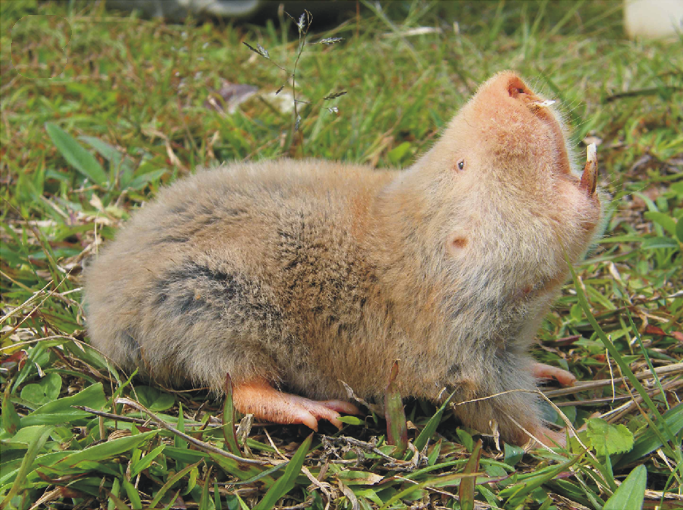It is hard to guess what a Silvery mole-rat weights. But we have the answer:
An adult Silvery mole-rat (Heliophobius argenteocinereus) on average weights 160 grams (0.35 lbs).
The Silvery mole-rat is from the family Bathyergidae (genus: Heliophobius). It is usually born with about 7 grams (0.02 lbs). They can live for up to 3.08 years. When reaching adult age, they grow up to 15.5 cm (0′ 7″). On average, Silvery mole-rats can have babies 1 times per year with a litter size of 2.
As a reference: An average human weights in at 62 kg (137 lbs) and reaches an average size of 1.65m (5′ 5″). Humans spend 280 days (40 weeks) in the womb of their mother and reach around 75 years of age.

The silvery mole-rat, silvery blesmol, or silky mole-rat (Heliophobius argenteocinereus) is a species of mole-rat of East Africa which occurs in southern Kenya, Tanzania, southeastern Democratic Republic of Congo, Mozambique and Malawi. Solitary and aggressive, little is known about its ecology or behavior. It is monotypic in the genus Heliophobius. A common species, the International Union for Conservation of Nature has rated it as being of “least concern”.
Animals of the same family as a Silvery mole-rat
We found other animals of the Bathyergidae family:
- Cape dune mole-rat with a weight of 804 grams
- Ochre mole-rat with a weight of 200 grams
- Mashona mole-rat with a weight of 65 grams
- Ansell’s mole-rat with a weight of 85 grams
- Naked mole-rat with a weight of 39 grams
- Mechow’s mole-rat with a weight of 272 grams
- Damaraland mole-rat with a weight of 112 grams
- Common mole-rat with a weight of 74 grams
- Bocage’s mole-rat with a weight of 93 grams
- Namaqua dune mole-rat with a weight of 389 grams
Animals with the same weight as a Silvery mole-rat
As a comparison, here are some other animals that weight as much as the Heliophobius argenteocinereus:
- Egyptian fruit bat bringing 134 grams to the scale
- Ruddy treeshrew bringing 168 grams to the scale
- Kintampo rope squirrel bringing 186 grams to the scale
- Lowland streaked tenrec bringing 129 grams to the scale
- Laminate vlei rat bringing 150 grams to the scale
- Little golden-mantled flying fox bringing 184 grams to the scale
- Egyptian fruit bat bringing 132 grams to the scale
- Red spiny rat bringing 150 grams to the scale
- Desert woodrat bringing 144 grams to the scale
- Greater Egyptian jerboa bringing 138 grams to the scale
Animals with the same size as a Silvery mole-rat
Not that size really matters, but it makes things comparable. So here are a couple of animals that are as big as Silvery mole-rat:
- Eastern rock elephant shrew with a size of 12.8 cm (0′ 6″)
- Slender squirrel with a size of 16.8 cm (0′ 7″)
- Long-tailed Talaud mosaic-tailed rat with a size of 15.2 cm (0′ 6″)
- Jentink’s flying squirrel with a size of 13.1 cm (0′ 6″)
- Goliath shrew with a size of 14.7 cm (0′ 6″)
- Red-bellied mosaic-tailed rat with a size of 14.3 cm (0′ 6″)
- Chiapan deer mouse with a size of 14 cm (0′ 6″)
- Hainan gymnure with a size of 13.5 cm (0′ 6″)
- Hispid cotton rat with a size of 16.7 cm (0′ 7″)
- Asian garden dormouse with a size of 13.7 cm (0′ 6″)
Animals with the same litter size as a Silvery mole-rat
Here is a list of animals that have the same number of babies per litter (2) as a Silvery mole-rat:
- Sarcophilus laniarius
- Desert woodrat
- Platypus
- Java pipistrelle
- Southern spiny pocket mouse
- Hershkovitz’s marmoset
- Sclater’s golden mole
- Volcano rabbit
- Durango chipmunk
- Aardwolf
Animals with the same life expectancy as a Silvery mole-rat
Completely different animals, but becoming as old as a Silvery mole-rat:
- Long-nosed echymipera with an average maximal age of 2.83 years
- Bower’s white-toothed rat with an average maximal age of 2.83 years
- Sminthopsis laniger with an average maximal age of 3.25 years
- South African pouched mouse with an average maximal age of 2.75 years
- Lesser white-toothed shrew with an average maximal age of 2.67 years
- Woodland vole with an average maximal age of 2.75 years
- Star-nosed mole with an average maximal age of 3 years
- Four-striped grass mouse with an average maximal age of 2.83 years
- Southwestern myotis with an average maximal age of 3.17 years
- Coast mole with an average maximal age of 3 years
